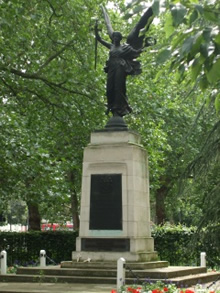Not Forgotten
GLA report says borough war memorials must be protected
A new London Assembly report has called for more protection for the capital’s 6,000 war memorials to prevent them being lost due to neglect, theft or redevelopment.
The report says the existing planning system does not offer enough protection to the monuments, many of which are in danger of being destroyed, stolen or neglected.
The Hammersmith and Fulham Historic Buildings Group Group recently carried out a survey of sculpture around the borough, which included around 25 war memorials. In their submission to the London Assembly's review, they concluded that local memorials were generally in good condition: “Our general impression is that War Memorials are well treated.”
However, according to the United Kingdom National Inventory of War Memorials (UKNIWM), two local memorials – a WWI white marble tablet and a WWII oak board in the Shepherd's Bush Baptist Tabernacle Church in Shepherd's Bush Road – are unaccounted for after last summer's devastating fire.
“29 July 2008: Church severely damaged by fire, memorial believed undamaged but its fate unknown,” a note on the UKNIWM list says for both entries.
The UKNIWM lists a handful of other war memorials in Shepherd's Bush, most of which are located in local churches. St Luke's Church in Uxbridge Road has memorials to the WWI and WW2 dead, St. Stephen's and St. Thomas's Church, also in Uxbridge Road, has a WWI memorial while the Methodist church in Askew Road hosts a memorial to the dead of both World Wars.
Perhaps the best known war memorial in Shepherd's Bush is the the winged bronze figure on the eastern corner of the Green. This bears the inscription: “In grateful and honoured memory of the men of this borough who fell in the Great War 1914-1918/ also of those who gave their lives in the Second World War 1939-1945”.
The Hammersmith and Fulham Historic Buildings Group say there are probably more local war memorials that could be added to the UKNIWM list: “We have only recently understood that St Andrew's (Bobola) Polish Catholic Church (Leysfield Road) is in part a War Memorial to the Polish Airforce in WWII, and has commemorative glass,” they write in their submission.
But the UKNIWM says the system for maintaining war memorials is not clear-cut: “Whilst many memorials are beautifully maintained by parish councils, Royal British Legion branches and other organisations, often no one person or body is legally responsible for their upkeep. When most memorials were erected, after the First World War, this problem was rarely considered and resources tended to be directed into fund-raising and construction rather than any provision for long term upkeep. In 1923, the War Memorials (Local Authorities' Powers) Act permitted local authorities to use public money for the maintenance of memorials, but there was no obligation to do this,” their website explains.
A spokesman for Hammersmith and Fulhan Council said: "The council regularly maintains the borough's war memorials and cleans or repair them when the need arises."
But the London Assembly's report calls on London's boroughs to tighten planning policies to cover the preservation of war memorials and says that over the next two years, boroughs should develop full inventories of the monuments with a link to the planning register. This would then trigger an alert when a planning proposal, potentially affecting a memorial, was received.
Tony Arbour AM, who led the investigation on behalf of the Assembly’s Planning and Housing Committee, said: “The thousands of war memorials in the capital, of all shapes and sizes, are a real and tangible reminder of Londoners who gave their todays for our tomorrows. To preserve London’s remaining memorials, planning processes must be changed to reflect the unique protection these aspects of our built environment require, and applied carefully by the Mayor and the boroughs.”
Dr Cathy Ross, Director of Collections and Learning, Museum of London, said: “War memorials are a testament to the extraordinary actions and bravery of ordinary Londoners, and are a moving and resonant part of the capital’s built environment. It is vital that we keep the memory of real London heroes and their sacrifices alive.”
July 22, 2009
Related links
|
